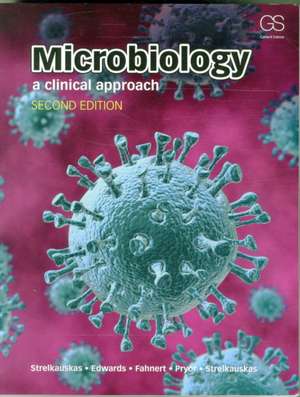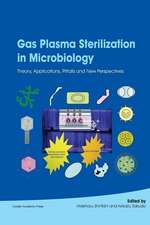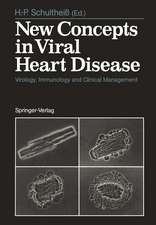Microbiology: A Clinical Approach
Autor Beatrix Fahnert, Anthony Strelkauskas, Angela Edwards, Greg Pryoren Limba Engleză Paperback – 14 iul 2015
The Second Edition includes a robust instructor ancillary package that allows professors to easily incorporate the book’s unique approach into their lectures. In addition to the many free resources for students—including the E-Tutor, Bug Parade, Flashcards, and MicroMovies—the new edition is supported by Garland Science Learning System.
The Garland Science Learning System is a homework platform designed to evaluate and improve student performance and allows instructors to select assignments on specific topics and review the performance of the entire class, as well as individual students, via the instructor dashboard. Students receive immediate feedback on their mastery of the topics, and will be better prepared for lectures and classroom discussions. The user-friendly system provides a convenient way to engage students while assessing progress. Performance data can be used to tailor classroom discussion, activities, and lectures to address students’ needs precisely and efficiently. For more information and sample material, visit http://garlandscience.rocketmix.com/.
Preț: 406.21 lei
Preț vechi: 441.54 lei
-8% Nou
Puncte Express: 609
Preț estimativ în valută:
77.73€ • 81.37$ • 64.31£
77.73€ • 81.37$ • 64.31£
Carte disponibilă
Livrare economică 15-29 martie
Livrare express 01-07 martie pentru 88.09 lei
Preluare comenzi: 021 569.72.76
Specificații
ISBN-13: 9780815345138
ISBN-10: 0815345135
Pagini: 760
Ilustrații: 632 colour illustrations, 330 colour illustrations, 300 colour line drawings
Dimensiuni: 210 x 280 x 25 mm
Greutate: 2.07 kg
Ediția:Revised
Editura: CRC Press
Colecția Garland Science
ISBN-10: 0815345135
Pagini: 760
Ilustrații: 632 colour illustrations, 330 colour illustrations, 300 colour line drawings
Dimensiuni: 210 x 280 x 25 mm
Greutate: 2.07 kg
Ediția:Revised
Editura: CRC Press
Colecția Garland Science
Public țintă
Adult education and UndergraduateCuprins
Learning Skills
PART I FOUNDATIONS
1. What Is Microbiology and Why Does It Matter?
2. Fundamental Chemistry for Microbiology
3. Essentials of Metabolism
4. An Introduction to Cell Structure and Host–Pathogen Relationships
PART II DISEASE MECHANISMS
5. Requirements for Infection
6. Transmission of Infection, the Compromised Host, Epidemiology, and Diagnosing Infections
7. Principles of Disease
8. Emerging and Re-Emerging Infectious Diseases
PART III CHARACTERISTICS OF DISEASE-CAUSING MICROORGANISMS
9. The Clinical Significance of Bacterial Anatomy
10. Bacterial Growth
11. Microbial Genetics and Infectious Disease
12. The Structure and Infection Cycle of Viruses
13. Viral Pathogenesis
14. Parasitic and Fungal Infections
PART IV HOST DEFENSE
15. The Innate Immune Response
16. The Adaptive Immune Response
17. Failures of the Immune Response
PART V CONTROL AND TREATMENT
18. Control of Microbial Growth with Disinfectants and Antiseptics
19. Antibiotics and Antimicrobial Drugs
20. Antibiotic Resistance
PART VI MICROBIAL INFECTIONS
21. Infections of the Respiratory System
22. Infections of the Digestive System
23. Infections of the Genitourinary System
24. Infections of the Central Nervous System
25. Infections of the Blood
26. Infections of the Skin and Eyes
Answers to Questions
Glossary
Pathogen List
PART I FOUNDATIONS
1. What Is Microbiology and Why Does It Matter?
2. Fundamental Chemistry for Microbiology
3. Essentials of Metabolism
4. An Introduction to Cell Structure and Host–Pathogen Relationships
PART II DISEASE MECHANISMS
5. Requirements for Infection
6. Transmission of Infection, the Compromised Host, Epidemiology, and Diagnosing Infections
7. Principles of Disease
8. Emerging and Re-Emerging Infectious Diseases
PART III CHARACTERISTICS OF DISEASE-CAUSING MICROORGANISMS
9. The Clinical Significance of Bacterial Anatomy
10. Bacterial Growth
11. Microbial Genetics and Infectious Disease
12. The Structure and Infection Cycle of Viruses
13. Viral Pathogenesis
14. Parasitic and Fungal Infections
PART IV HOST DEFENSE
15. The Innate Immune Response
16. The Adaptive Immune Response
17. Failures of the Immune Response
PART V CONTROL AND TREATMENT
18. Control of Microbial Growth with Disinfectants and Antiseptics
19. Antibiotics and Antimicrobial Drugs
20. Antibiotic Resistance
PART VI MICROBIAL INFECTIONS
21. Infections of the Respiratory System
22. Infections of the Digestive System
23. Infections of the Genitourinary System
24. Infections of the Central Nervous System
25. Infections of the Blood
26. Infections of the Skin and Eyes
Answers to Questions
Glossary
Pathogen List
Recenzii
"This book is true to its title, providing an up-to-date overview of infection from a clinical perspective. However, with credit, the book does not ignore the basic science behind infection, with the introductory chapters covering general background information such as the fundamental chemistry for microbiology, characteristics of micro-organisms and host immune response. The main advantage of this book is that it is organized by systems: linking the clinical syndrome to its microbiology. The easily navigable chapters are enriched with outstanding illustrations and informative tables, and finished with salient summary points. In fact, the learning aids presented far exceeded my expectations for a textbook."
–Microbiology Today
"…this book is different from the other microbiology textbooks currently on the market. The main difference is that it makes a real and tangible effort to put students, or better, the learning process, center stage."
–British Society for Immunology
"The book is extensively illustrated throughout with photographs and easy to understand schematics. It is well-supported by a website for students….Instructor resources include…PowerPoint slides, question banks, and even lecture notes. These are so good I will be using it!"
–The Biologist
"The book is well suited for beginning nursing students and undergraduate students preparing for healthcare careers. The authors’ educational and teaching experiences situate them well to write this expansive introduction."
–Doody’s Book Notes
–Microbiology Today
"…this book is different from the other microbiology textbooks currently on the market. The main difference is that it makes a real and tangible effort to put students, or better, the learning process, center stage."
–British Society for Immunology
"The book is extensively illustrated throughout with photographs and easy to understand schematics. It is well-supported by a website for students….Instructor resources include…PowerPoint slides, question banks, and even lecture notes. These are so good I will be using it!"
–The Biologist
"The book is well suited for beginning nursing students and undergraduate students preparing for healthcare careers. The authors’ educational and teaching experiences situate them well to write this expansive introduction."
–Doody’s Book Notes
Notă biografică
Anthony Strelkauskas, Angela Edwards, Beatrix Fahnert, Greg Pryor, Jennifer Strelkauskas
Descriere
As with the successful first edition, the new edition of Microbiology: A Clinical Approach is written specifically for pre-nursing and allied health students. It is clinically-relevant throughout and uses the theme of infection as its foundation. Microbiology is student-friendly: its text, figures, and electronic resources have been carefully designed to help students understand difficult concepts and keep them interested in the material.
The Second Edition includes a robust instructor ancillary package that allows professors to easily incorporate the book’s unique approach into their lectures. In addition to the many free resources for students—including the E-Tutor, Bug Parade, Flashcards, and MicroMovies—the new edition is supported by Garland Science Learning System.
The Garland Science Learning System is a homework platform designed to evaluate and improve student performance and allows instructors to select assignments on specific topics and review the performance of the entire class, as well as individual students, via the instructor dashboard. Students receive immediate feedback on their mastery of the topics, and will be better prepared for lectures and classroom discussions. The user-friendly system provides a convenient way to engage students while assessing progress. Performance data can be used to tailor classroom discussion, activities, and lectures to address students’ needs precisely and efficiently. For more information and sample material, visit http://garlandscience.rocketmix.com/.
The Second Edition includes a robust instructor ancillary package that allows professors to easily incorporate the book’s unique approach into their lectures. In addition to the many free resources for students—including the E-Tutor, Bug Parade, Flashcards, and MicroMovies—the new edition is supported by Garland Science Learning System.
The Garland Science Learning System is a homework platform designed to evaluate and improve student performance and allows instructors to select assignments on specific topics and review the performance of the entire class, as well as individual students, via the instructor dashboard. Students receive immediate feedback on their mastery of the topics, and will be better prepared for lectures and classroom discussions. The user-friendly system provides a convenient way to engage students while assessing progress. Performance data can be used to tailor classroom discussion, activities, and lectures to address students’ needs precisely and efficiently. For more information and sample material, visit http://garlandscience.rocketmix.com/.
























